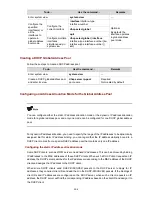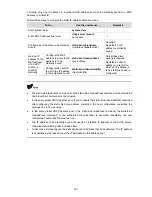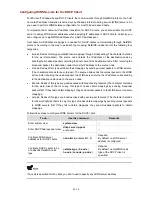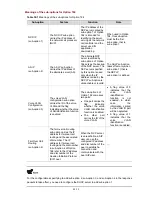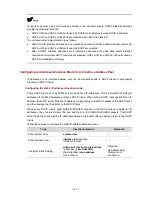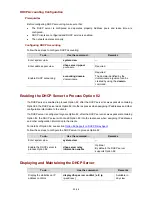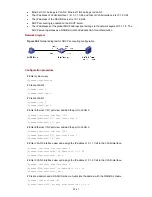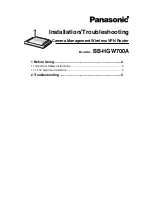
39-19
z
The dhcp server forbidden-ip command can be executed repeatedly. That is, you can configure
multiple IP addresses that are not dynamically assigned to DHCP clients.
z
Use the dhcp server forbidden-ip command to configure the IP addresses that are not assigned
dynamically in global address pools and interface address pools.
z
If an IP address that is not to be automatically assigned has been configured as a statically-bound
IP address, the DHCP server still assigns this IP address to the client whose MAC address or client
ID has been bound.
Configuring a Domain Name Suffix for the DHCP Client
You can configure a suffix for the domain name in each DHCP interface address pool on the DHCP
server. The DHCP server provides the domain name suffix together with an IP address for a requesting
DHCP client.
Follow these steps to configure a domain name suffix for the client:
To do…
Use the command…
Remarks
Enter system view
system-view
—
interface interface-type interface-number
dhcp server domain-name
domain-name
In the current
interface address
pool
quit
Configure
a domain
name
suffix for
the clients
In multiple
interface address
pools in system
view
dhcp server domain-name
domain-name
{
all
|
interface interface-type
interface-number
[
to interface-type
interface-number
] }
Required
Not configured by
default.
Configuring DNS Servers for the DHCP Client
If a client accesses a host on the Internet through domain name, DNS is needed to translate the domain
name into the corresponding IP address. To enable DHCP clients to access hosts on the Internet
through domain names, a DHCP server is required to provide DNS server addresses while assigning IP
addresses to DHCP clients. Currently, you can configure up to eight DNS server addresses for a DHCP
interface address pool.
Follow these steps to configure DNS servers for the DHCP client:


